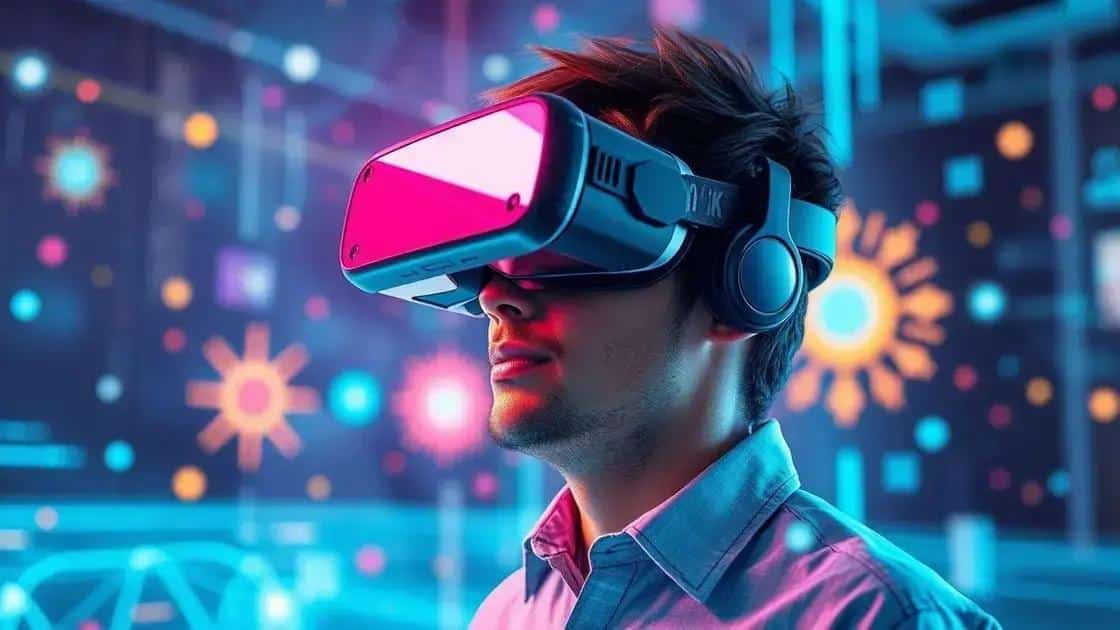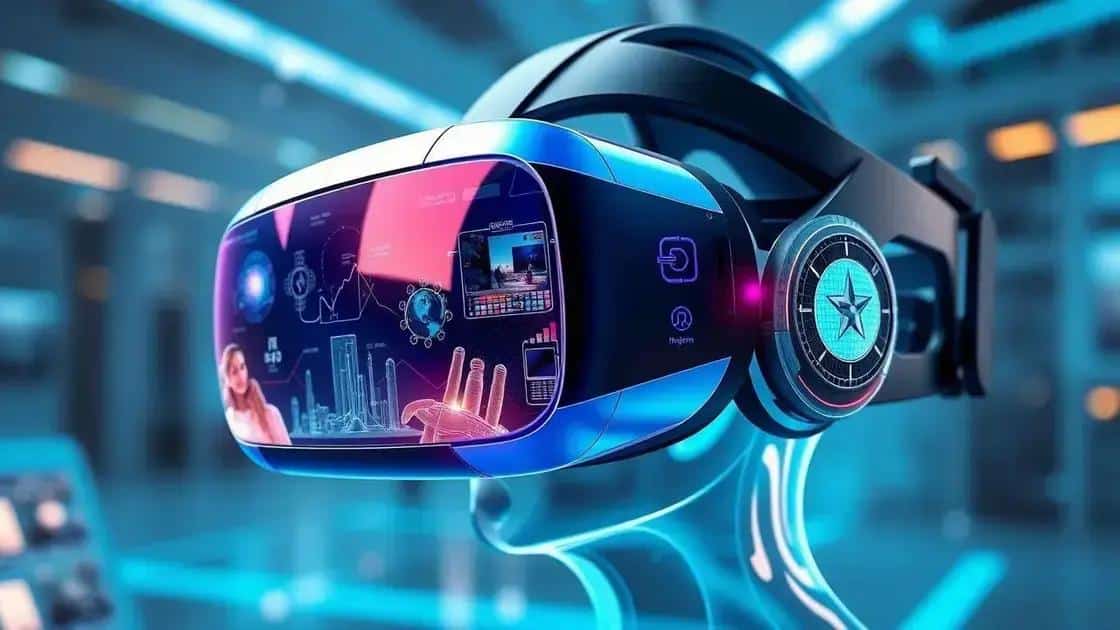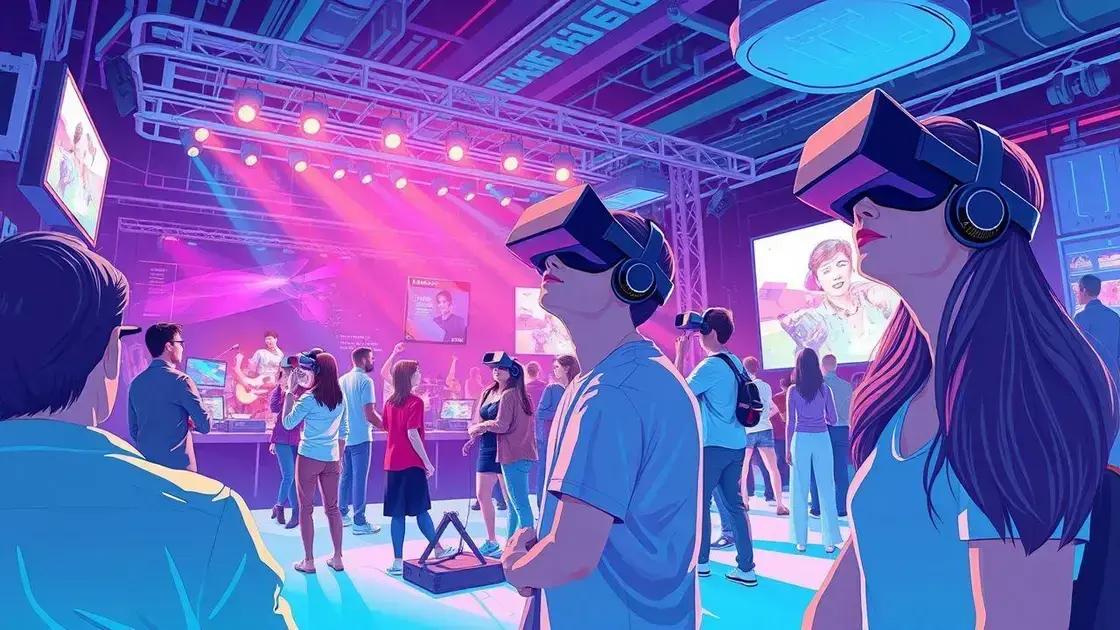VR/AR entertainment industry trends you need to know

VR/AR entertainment industry trends are revolutionizing user engagement by creating immersive, interactive experiences that personalize content and enhance learning, gaming, and marketing across various sectors.
VR/AR entertainment industry trends are transforming how we engage with media and experiences. Have you noticed how immersive content can pull you in like never before? Let’s dive into what’s shaping this exciting landscape.
the rise of immersive storytelling
The rise of immersive storytelling has changed the way we experience narratives. With advancements in technology, stories are no longer confined to pages or screens; they are now interactive and engaging. Today, audience members can step into tales and live them as participants rather than just spectators.
What is Immersive Storytelling?
Immersive storytelling combines traditional narratives with elements of virtual reality and augmented reality. This approach creates environments where viewers can interact with characters and storylines in a more profound manner. These experiences allow for deeper emotional connections.
Key Components of Immersive Storytelling
- Interactivity: Engaging users in decision-making processes that affect the story’s outcome.
- Realism: Utilizing technology to create believable and captivating settings.
- Personalization: Tailoring narratives to fit individual preferences and choices.
The technology behind immersive storytelling continues to evolve rapidly. Innovations like 360-degree video and advanced sound design enhance the viewer’s experience. By using these tools, creators are able to transport audiences to fantastic worlds, from ancient civilizations to futuristic landscapes.
Moreover, brands are leveraging immersive storytelling to connect with their customers. By crafting narratives that resonate emotionally, companies can foster loyalty and create memorable experiences. This technique allows audiences to feel a sense of belonging and attachment to the brand’s story.
Future Trends in Immersive Storytelling
As the technology matures, audiences can expect even more innovative experiences. New tools and platforms will drive the rise of immersive storytelling further, enabling creators to employ artificial intelligence and machine learning for dynamic story generation. These advancements will lead to richer and more interactive narratives that adapt to audience feedback.
The future of storytelling is in immersion. With VR and AR creating opportunities that were unimaginable just a few years ago, the possibilities are endless. Whether through gaming, films, or virtual events, immersive storytelling promises to provide experiences that captivate audiences like never before.
key technologies driving VR and AR

Key technologies play a vital role in driving the evolution of VR and AR. These tools not only enhance user experiences but also expand the possibilities for storytelling and interaction. As these technologies continue to advance, they reshape industries from entertainment to education.
Virtual Reality Technologies
Virtual reality relies on several technologies to create fully immersive environments. With high-quality headsets, users can escape into different realities, engaging with digital worlds as if they were real. Tracking systems allow users to move freely, enhancing the sense of presence within these environments.
Augmented Reality Innovations
Augmented reality overlays digital elements onto the real world, changing how we perceive our surroundings. This technology uses smartphones and AR glasses to display information and interactive elements alongside the physical environment, making experiences richer and more informative.
- Computer Vision: The ability of computers to understand and interpret visual information from the world.
- Depth Tracking: Technology that measures the distance to various objects, allowing for accurate placement of digital objects in AR.
- SLAM (Simultaneous Localization and Mapping): This technology helps devices understand their position in real-time while mapping their surroundings.
As technology progresses, the hardware and software behind VR and AR become more sophisticated. Advances in graphics processing, latency reduction, and connectivity bring richer and more responsive experiences. Features like haptic feedback further deepen immersion by simulating touch and interaction.
The gaming industry has significantly benefited from these technological advancements. New VR games create thrilling interactive experiences that pull players into unimaginable realms. Meanwhile, AR is used in mobile apps that turn our world into a playground filled with interactive elements.
Future trends suggest more seamless integration of VR and AR technologies in everyday life. From remote work to virtual tourism, the potential applications span across numerous fields. Educators can use AR to make learning more engaging, while professionals can train in VR settings that mimic real-world scenarios.
impact of VR/AR on user engagement
The impact of VR and AR on user engagement is profound. These technologies create experiences that captivate audiences, drawing them into interactive worlds. Users are no longer passive observers; they become part of the story, which significantly enhances their emotional connection to content.
Enhancing Immersion
Both VR and AR offer unique sensory experiences that traditional media cannot match. VR immerses users in a completely digital space, while AR blends digital elements with the real world. This immersion leads to higher levels of engagement and retention of information.
Interactivity and Participation
Unlike standard content, VR and AR invite users to interact with their surroundings actively. This level of participation can involve making choices that affect the narrative or exploring virtual environments. This hands-on approach keeps users interested and invested in the outcome.
- Gamification: Incorporating game-like elements increases motivation and encourages participation.
- Real-Time Feedback: Instant responses to user actions enhance the experience and keep users engaged.
- Social Interaction: VR can support multi-user experiences, allowing friends to join together in virtual environments.
Moreover, brands leverage VR and AR to create memorable marketing campaigns. By offering unique, interactive experiences, they capture consumer attention in ways that traditional advertising cannot. Customers are more likely to remember brands that provide engaging experiences.
Research shows that users are more likely to share positive experiences with others, further expanding the reach of VR and AR content. As more people engage with this technology, the network effects amplify overall user engagement. The potential for viral sharing through social media transforms how content reaches wider audiences.
Ultimately, the integration of VR and AR into various industries continues to evolve. Educational institutions, for example, utilize these technologies to create engaging learning environments. Students can interact with complex concepts in a hands-on manner, leading to improved comprehension and retention.
future predictions for entertainment in VR/AR

The future of entertainment in VR and AR looks promising and exciting. As technology continues to advance, the possibilities for immersive experiences will grow. These innovations will change the way we consume media, participate in games, and engage with stories.
Enhanced User Experiences
In the coming years, we can expect VR and AR to become even more integrated into daily life. Imagine attending live concerts or sports events from the comfort of your home, feeling as if you are part of the crowd. These technologies will blur the lines between reality and digital worlds.
Integration with Artificial Intelligence
As artificial intelligence (AI) continues to develop, it will have a significant impact on VR and AR experiences. AI can create dynamic narratives that adapt based on user choices. This means that every time someone engages with the content, they’ll have a unique experience.
- Personalized Content: Using AI to tailor stories and environments specifically for each user.
- Realistic Characters: AI-driven characters will interact in more natural and believable ways, making stories more engaging.
- Adaptive Environments: Changing settings based on user inputs and preferences, creating a more immersive atmosphere.
Gaming will also witness incredible advancements. We may see games that combine physical movements with virtual elements, requiring players to move around in their environments. This will add a new layer of interaction and fun.
Educational platforms will benefit hugely as well. Students will learn history by virtually walking through ancient cities or exploring the human body in 3D. Such immersive learning tools will make education far more engaging and effective.
As the technology gets more affordable, expect to see a surge in VR and AR content across various industries. Museums and galleries will provide virtual tours, enabling worldwide access to art and culture. This democratization of access will change who gets to experience these forms of entertainment and education.
FAQ – Frequently Asked Questions about VR/AR in Entertainment
How does VR enhance user engagement?
VR creates immersive experiences that draw users in, allowing them to interact with the content actively.
What role does AI play in VR and AR?
AI helps personalize experiences by adapting content in real-time based on user interactions, making each engagement unique.
Can VR and AR be used in education?
Yes, VR and AR can transform education by providing interactive and engaging learning environments that enhance understanding.
What are the future predictions for VR/AR in entertainment?
Future trends suggest that VR and AR will become more integrated into daily life, offering more personalized and engaging content across various industries.





